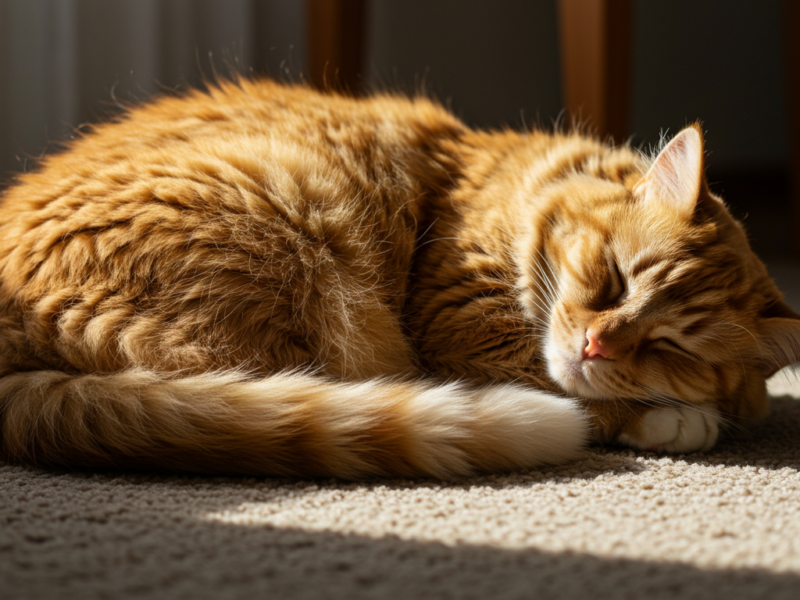Cats are curious creatures, often drawn to the smells and textures of human food. However, many common foods are toxic to felines, posing serious health risks. Understanding which foods to avoid can save your cat from illness—or even save their life. This guide explores the science behind feline toxicity, lists dangerous foods, and offers safe alternatives.
Section 1: Why Are Some Foods Toxic to Cats?
Cats have unique metabolic pathways that differ from humans and even dogs. Key factors include:
- Limited Enzymes:
- Cats lack certain enzymes needed to break down compounds like theobromine (in chocolate) or allicin (in garlic).
- Small Size:
- Even small amounts of toxic substances can have a significant impact on a cat’s body.
- Obligate Carnivores:
- Cats require a diet high in animal protein and low in carbohydrates. Many human foods disrupt this balance.
Keep your Cat Active
Interactive Cat Smart Ball Toy 2.0, Automatic Power Rolling Ball
It is a simulated interactive hunting toy with a two-in-one design that allows your cat to enjoy chasing and hunting at the same time.
Section 2: Top 10 Dangerous Foods for Cats
- Chocolate:
- Toxin: Theobromine and caffeine.
- Effect: Vomiting, diarrhea, seizures, and cardiac arrest.
- Lethal Dose: 100–200 mg/kg (a small square of dark chocolate can be fatal).
- Onions and Garlic:
- Toxin: Thiosulfate → destroys red blood cells (hemolytic anemia).
- Risk: All forms (raw, cooked, powdered) are toxic.
- Alcohol:
- Effect: CNS depression → respiratory failure, coma.
- Risk: Even small amounts (e.g., beer, wine-soaked foods) are dangerous.
- Caffeine:
- Found In: Coffee, tea, energy drinks.
- Effect: Rapid heart rate, tremors, seizures.
- Grapes and Raisins:
- Toxin: Unknown (tartaric acid suspected).
- Effect: Acute kidney failure.
- Xylitol:
- Found In: Sugar-free gum, peanut butter, baked goods.
- Effect: Rapid insulin release → hypoglycemia (weakness, seizures).
- Raw Dough:
- Risk: Fermentation in the stomach produces ethanol → alcohol poisoning.
- Secondary Risk: Dough expansion → gastric bloat.
- Dairy Products:
- Risk: Most cats are lactose intolerant, leading to diarrhea and stomach upset.
- Bones:
- Risk: Splintering → gastrointestinal perforation or blockages.
- Fat Trimmings and Greasy Foods:
- Risk: Pancreatitis (inflammation of the pancreas).
Section 3: Lesser-Known Hazards
- Avocado:
- Toxin: Persin (in pits, skin, leaves).
- Effect: Vomiting, diarrhea, pancreatitis.
- Macadamia Nuts:
- Effect: Weakness, vomiting, hyperthermia.
- Raw Eggs:
- Risk: Salmonella or E. coli infection; avidin in egg whites interferes with biotin absorption.
- Salt:
- Effect: Sodium ion poisoning → vomiting, diarrhea, brain swelling.
Section 4: Emergency Protocol
- Identify the Toxin:
- Note the type, amount ingested, and time elapsed.
- Contact a Professional:
- ASPCA Animal Poison Control: (888) 426-4435 (fee: $95).
- Local Vet: Have their emergency number saved.
- Do NOT Induce Vomiting If:
- The cat is unconscious.
- The toxin is caustic (e.g., bleach, batteries).
- First Aid:
- Activated Charcoal: Administer only under vet guidance to absorb toxins.
- Hydrogen Peroxide (3%): For induced vomiting only if instructed (1 tsp per 5 lbs, max 3 tsp).
Section 5: Safe Alternatives for Treats
- Proteins:
- Cooked chicken (boneless, skinless).
- Small amounts of cooked fish (no bones, no seasoning).
- Vegetables:
- Steamed carrots or green beans (in moderation).
- Commercial Cat Treats:
- Choose high-quality, vet-approved options.
Section 6: Debunking Myths About Cat Diets
- “Cats Can Eat Dog Food”:
- Reality: Dog food lacks taurine, an essential amino acid for cats.
- “A Little Chocolate Won’t Hurt”:
- Reality: Even small amounts of dark chocolate can be lethal.
- “Cats Love Milk”:
- Reality: Most cats are lactose intolerant and develop digestive issues.
Section 7: Case Study – A Close Call
Background: A 3-year-old Siamese cat named Luna ingested a small piece of onion from her owner’s plate.
Symptoms: Vomiting, lethargy, pale gums.
Action: The owner rushed Luna to the vet, where she received activated charcoal and IV fluids.
Outcome: Luna recovered fully after 48 hours of monitoring.
In Short: Cats have unique dietary needs and sensitivities. By avoiding toxic foods and providing safe, species-appropriate alternatives, you can protect your cat’s health and ensure they live a long, happy life. When in doubt, consult your vet—because prevention is always better than cure. ?
2.0 Automatic Litter Box
Self Cleaning Cat Litter Box, Upgraded Seal Performance Automatic Cat Litter Box
- PETKIT PuraMax 2 – Caja de arena para gatos autolimpiable
Pet Crate
4-Doors Portable Soft-Sided Folding Travel Crate Kennel for cat, Dog, and Other Small Animals, Grey, L 36" x 24" x 24"
- Transportín de viaje plegable grande de 4 puertas con paredes suaves para gatos, perros, conejos y otros animales pequeños.






